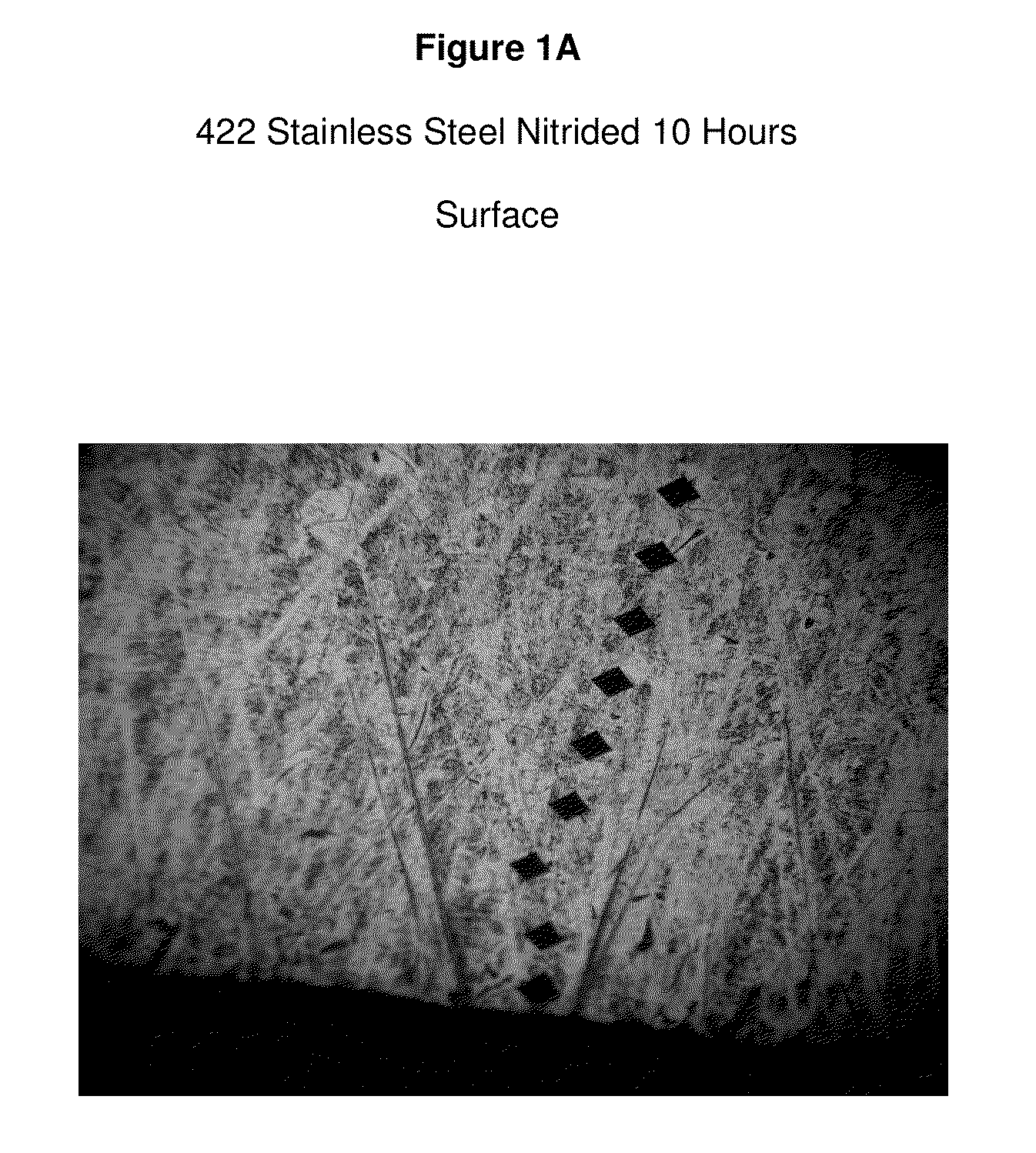Nitrogen Alloyed Martensitic Stainless Steel and Process
a technology of martensitic stainless steel and nitrogen alloy, applied in the direction of solid-state diffusion coating, coating, chemistry apparatus and processes, etc., can solve the problems of constant exposure to high temperatures, pressures, friction and stress, and insufficient corrosion resistance of landing struts and tailhooks, and achieve the effect of improving the kinetics of the diffusion process
- Summary
- Abstract
- Description
- Claims
- Application Information
AI Technical Summary
Benefits of technology
Problems solved by technology
Method used
Image
Examples
example i
[0046]A martensitic stainless steel bushing was placed in a partial pressure vacuum furnace, which was then evacuated to about −100μ pressure. Hydrogen gas was introduced and the temperature was elevated to 1000° F. (540° C.) to activate the surface. A partial pressure of nitrogen gas was introduced and the temperature was elevated to 2000° F. (1095° C.). The nitrogen gas flow was increased to 630 torr and the bushing was nitrided under these conditions for a total of 10 hours. The bushing was quenched in nitrogen at 10 barr pressure to ambient in 53 seconds. The bushing was then stabilized in liquid nitrogen at −300° F. for 30 minutes and tempered in air for 2 hours.
[0047]The stainless steel bushing nitrided under the above conditions was sectioned to permit micro-hardness readings from the surface to a depth of 1 mm. at 0.1 mm intervals. Subsequent hardness measurements were continued to measure the hardness over the total cross section. To accomplish this, the cross section was m...
example 2
[0053]Piston rods machined from martensitic stainless steel (422 XD and 440 C stainless steel rods) were surface nitrided to a hardness of 60 HRC which continued to a depth of 0.030 inches (1 mm). Each of the piston rods was provided the same nitriding and stabilization treatment. However, the 422 XD piston rods were tempered at 950° F. (510° C.), whereas the 440 C piston rods were tempered at 200° F. (95° C.) to a specific hardness.
[0054]The 440 C and the 422 XD stainless steel piston rods were through hardened to a hardness of 60 HRC. Therefore, it is evident that the time required to nitride a sample of stainless steel using the process of the present invention is considerably shorter if a tougher core is required. The 422 XD piston rod did not achieve quite as high a through hardness as the 440 C piston rod, and the microstructure consisted of fine nitrides, whereas the 440 C microstructure contained blocky, larger nitrides. For these reasons, the 422 XD alloy is preferred. Part...
example 3
[0057]Spray paint pumps distribute sprayed paint under an atomizing pressure of 3,000 psi. One of the main constituents of the pump is the piston rod. In practice, the piston rod is protected from erosion by seals that prevent hard abrasive particles comprising the pigments from abrading the piston rod. However, when sustaining service, the seals begin to leak and thereby permit pigment to abrade the piston rod. Therefore the piston rod requires some degree of surface protection against abrasion, while not compromising the corrosion resistance of the piston rod. The material of choice is a 440 C martensitic stainless steel. When tempered, this steel has strength, ductility and toughness. The process of the present invention was utilized to provide hardness and wear resistance to the 440 C stainless steel alloy.
[0058]Three piston rods were placed in a vacuum furnace and hung vertically in the middle from wires so that all surfaces were available for the deposition of gaseous nitrogen...
PUM
| Property | Measurement | Unit |
|---|---|---|
| pressure | aaaaa | aaaaa |
| partial pressure | aaaaa | aaaaa |
| temperature | aaaaa | aaaaa |
Abstract
Description
Claims
Application Information
 Login to View More
Login to View More - R&D
- Intellectual Property
- Life Sciences
- Materials
- Tech Scout
- Unparalleled Data Quality
- Higher Quality Content
- 60% Fewer Hallucinations
Browse by: Latest US Patents, China's latest patents, Technical Efficacy Thesaurus, Application Domain, Technology Topic, Popular Technical Reports.
© 2025 PatSnap. All rights reserved.Legal|Privacy policy|Modern Slavery Act Transparency Statement|Sitemap|About US| Contact US: help@patsnap.com



